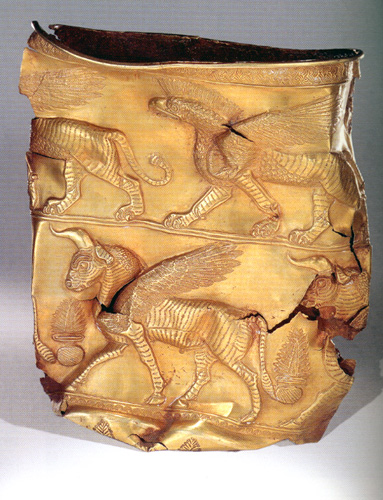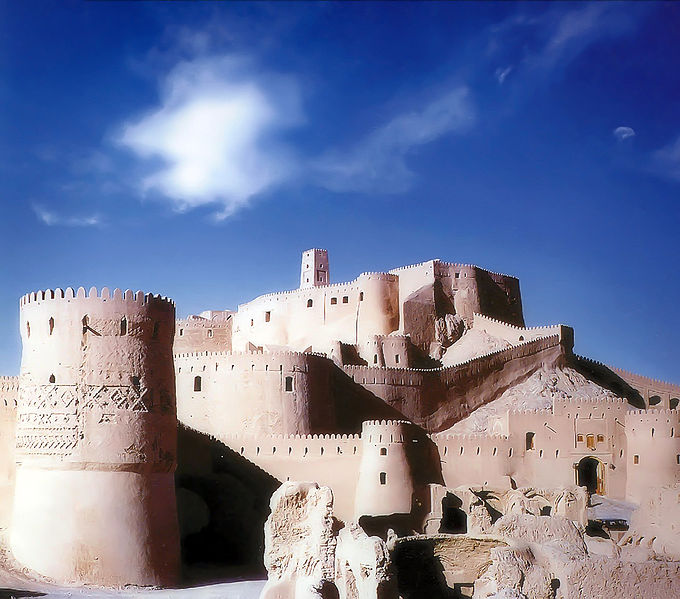 Golden Cup at National Museum of Iran. First half of first millennium BCE
History of Iran
Golden Cup at National Museum of Iran. First half of first millennium BCE
History of Iran
History of Iran and Greater Iran (also referred to as the "Iranian Cultural Continent" by the Encyclopedia Iranica)�- consisting areas from Euphrates in the west to Indus River and Syr Darya in the east and from Caucasus, Caspian sea and Aral Sea in the north to Persian gulf and Gulf of Oman in the south which includes the modern nations Iran, Azerbaijan, Afghanistan, Turkmenistan, Tajikistan, Uzbekistan, eastern part of Turkey and Iraq and western part of Pakistan and surrounding regions which is one of the world's oldest continuous major civilizations. � covers thousands of years, from the ancient civilization on the Iranian plateau, Mannaeans civilization in Azarbaijan, Shahr-i Sokhta (Burned City) near Zabol in Sistan va Baluchestan, and the ancient Kingdom of Jiroft in Kerman followed by the kingdom of Elam and the Median, Achaemenid, the Parthian, the Sassanian dynasties and following Empires to the modern Islamic Republic of Iran.
 Geographical extent of Iranian influence in the 1st century BCE. The Parthian Empire (mostly Western Iranian) is shown in red, other areas, dominated by Scythia (mostly Eastern Iranian), in orange.
Geographical extent of Iranian influence in the 1st century BCE. The Parthian Empire (mostly Western Iranian) is shown in red, other areas, dominated by Scythia (mostly Eastern Iranian), in orange.
So significant is the role of Iran in history that Georg Hegel considers Iranians to be "the first historic people" and states:
"In Persia first arises that light which shines itself and illuminates what is around...The principle of development begins with the history of Persia; this constitutes therefore the begining of history".
And Richard Nelson Frye further verifies:
"Few nations in the world present more of a justification for the study of history than Iran."
Ancient history
Iranian history before the Aryans
There are records of numerous ancient and technologically advanced civilizations on the Iranian plateau before the arrival of Aryan tribes from the north, many of whom are still unknown to historians today. Archeological findings place knowledge of Iranian prehistory at Lower Paleolithic times (800,000 years ago). These evidence are in form of stone tools made on quartz which have been found at Kashafrud.
There are more cultural remains of Neanderthal man in Iran which mainly have been found in the Zagros region and fewer in central Iran. Some of these important Neandertal sites are Bisetun, Kunji, Warwasi, Qaleh Bozi.
Evidence for Upper Paleolithic and Epipaleolithic periods are known mainly from the Zagros region in the caves of Kermanshah and Khoramabad. The earliest sedentary cultures date from 10,000-7,000 years ago. This evidence comes from archaeological sites such as Ganj Dareh, Sarab, Mushki,tepe Chaxmaq. In 6000 BCE the world saw a fairly sophisticated agricultural society and proto-urban population centers. The south-western part of Iran was part of the Fertile Crescent where most of humanity's first major crops were grown. 7000 year old jars of wine excavated in the Zagros Mountains (now on display at The University of Pennsylvania) and ruins of 7000 year old settlements such as Sialk are further testament to this. Many dynasties have ruled Persia throughout the ages. Scholars and archeologists are only beginning to discover the scope of the independent, non-Semitic Elamite Empire and Jiroft civilizations 5000 years ago.
At the end of second millennium, the Aryan nomads from central Asia settled in Persia. These are some of the civilizations in Iran before the Aryans: Zayandeh Rud civilization, Ganj Dareh,Teppe Sialk, Shahr-e Sukhteh, Marlik culture, Luristan culture, Mannaeans kingdom,Kassites, Kingdom of Jiroft, Elamite kingdom.
Early history and the Median and Achaemenian Empires (3200 BCE � 330 BCE)
Iran has been inhabited by humans since pre-historic times and recent discoveries have begun to shed light upon what these ancient cultures were like in Iran, centuries before the earliest civilizations arose in nearby Mesopotamia.[8]
The written history of Persia (Iran) begins in about 3200 BCE with the Proto-Iranian civilization, followed by the Elamites. The arrival of the Aryans (Indo-Iranians) in the third and second millennium BCE and the establishing of the Median dynasty (728�550 BCE) culminated in the first Iranian Empire. The Medes are credited with the foundation of Iran as a nation and empire, and established the first Iranian empire, the largest of its day until Cyrus the Great established a unified empire of the Medes and Persians leading to the Achaemenian Empire (648�330 BCE).
 The 2500 year old ruins of Persepolis (Old Persian: Parsa; Modern Persian: Takht-e Jamshid)
The 2500 year old ruins of Persepolis (Old Persian: Parsa; Modern Persian: Takht-e Jamshid)
Cyrus the Great created the Cyrus Cylinder, considered to be the first declaration of human rights. He was the first king whose name has the suffix "Great" and the first Shah of Iran to be known by that title. Cyrus also banned slavery in all of the conquered areas that became the Persian Empire. Cyrus' seminal ideas greatly influenced later human civilizations; Cyrus' principles of ruling � advocating "love" rather than "fear" � influenced the original U.S. Constitution.
 The Arg-e Bam citadel, built before 500 BCE. A great example of Iranian castles of the time
The Arg-e Bam citadel, built before 500 BCE. A great example of Iranian castles of the time
After Cyrus' death, his son Cambyses ruled for seven years (531-522 BCE) and continued his father's work of conquest, making significant gains in Egypt. A power struggle followed Cambyses' death and, despite his tenuous connection to the royal line, Darius was declared king (ruled 522-486 BCE). He was to be arguably the greatest of the ancient Persian rulers.
Darius' first capital was at Susa, and he started the building programme at Persepolis. He built a canal between the Nile and the Red Sea, a forerunner of the modern Suez Canal. He improved the extensive road system, and it is during his reign that mention is first made of the Royal Road (shown on map), a great highway stretching all the way from Susa to Sardis with posting stations at regular intervals.
Major reforms took place under Darius. Coinage, in the form of the daric (gold coin) and the shekel (silver coin) was introduced to the world, and administrative efficiency was increased. The Old Persian language appears in royal inscriptions, written in a specially adapted version of cuneiform.
Under Cyrus the Great and Darius the Great, the Persian Empire eventually became the largest and most powerful empire in human history up until that point, ruling and administrating over most of the then known world.Their greatest achievement was the empire itself. The Persian Empire represented the world's first global superpower, and was based on a model of tolerance and respect for other cultures and religions.
Alexander of Macedon, also known in the Zoroastrian Arda Wiraz N�mag as "the accursed Alexander" (due to his conquest of the Persian Empire and the destruction of its cities, including the capital Persepolis), conquered Persia in 333 BCE only to be followed shortly by two more vast and unified Iranian empires that shaped the pre-Islamic identity of Iran and Central Asia: the Parthian (250 BCE-226 CE) and Sassanian (226-650 CE) dynasties. The latter dynasties also defeated the Roman empire at the height of its power on several occasions.
The Silk Road, connecting Persia with China was significant not only for the development and flowering of the great civilizations of China, ancient Egypt, Mesopotamia, Persia, India and Rome but also helped to lay the foundations of our modern world.
Zoroastrianism
Zoroastrianism is the religion and philosophy based on the teachings ascribed to the prophet Zoroaster (Zarathustra, Zartosht). Mazdaism is the religion that acknowledges the divine authority of Ahura Mazda, proclaimed by Zoroaster to be the one uncreated Creator of all (God).
As demonstrated by Zoroastrian creed and articles of faith, the two terms are effectively synonymous. In a declaration of the creed � the Fravarānē � the adherent states:
"�I profess myself a devotee of Mazda, a follower of Zarathustra." (Yasna 12.2, 12.8)
Some scholars have suggested that Zoroastrianism was where the first prophet of a monotheistic faith arose, claiming Zoroastrianism as being "the oldest of the revealed credal religions, which has probably had more influence on mankind directly or indirectly, more than any other faith".
Zoroastrianism was once the dominant religion of much of Greater Iran.

 Faravahar (or Ferohar), one of the primary symbols of Zoroastrianism, believed to be the depiction of a Fravashi (guardian spirit)
Faravahar (or Ferohar), one of the primary symbols of Zoroastrianism, believed to be the depiction of a Fravashi (guardian spirit)

